-
272009. 10
No. 38 View. 15853
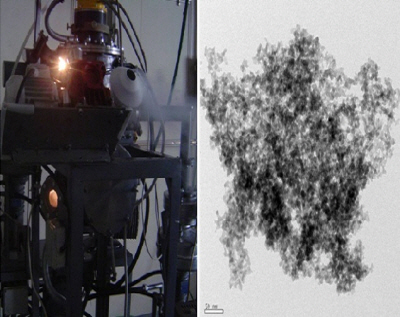
KAERI's nanoparticle production technology ranks third in Russia's 100 best pate...
KAERI's nanoparticle production technology ranks third in Russia's 100 best patentsExcellence of ceramic nanoparticle production, formation technology using electron beam recognized. (Photo) Nanoparticle production technology (left) using an electron beam; zirconia nanoparticles produced using the technology. A nanoparticle production technology developed by a Korean research team through international collaboration was found to rank third among all patents registered in Russia last year. The Korea Atomic Energy Research Institute (President Yang Myung-seung) said on October 12 that "The alumina(Al2O3), zirconia(ZrO2) ceramic nanoparticle production technology and actual shape formation technology using the magnetic pulse compression method" ranked third among the 100 best patents of 2008 as recently selected by the Russian government. The technology was developed through international joint research between KAERI and the Institute of Electrophysics of Russia. Notably, the technology that ranked third among patents in Russia allows for the production of high purity nanoparticles that are consistent in size measuring 10 nanometers by projecting in a concentrated manner electron beams generated with a pulse electron beam accelerator into a narrow space, thus evaporating and compressing the target metal. Also drawing keen attention was a discrete technology that allows for the production of nanoparticles in a desired shape while maintaining a consistent nano-structure and high density using a magnetic pulse compression technique, a type of dynamic compaction. The technology is an integration of Russia's electron beam apparatus production technology and Korea's electronic system technology and nanoparticle production technology. Equipment such as the beam array device was produced in Russia, while studies for characterization were conducted in Korea to complete the technology. KAERI has completed the design and production of an electron beam apparatus that uses solid state targets for the first time in the world through close collaboration with the Institute of Electrophysics of Russia, and has finished the production of nanoparticles. In cost analysis, the technology is highly economical as it allows for the production of high-purity particles through a low-energy process thanks to high-energy proficiency. Additionally, it will have applications in diverse fields, including the development of ultra-fine structured parts and components, as it allows for formation in sophisticated shapes, while maintaining the excellence of nanoparticles. Lee Chang-kyu, senior researcher at the Atomic Materials Research Division at KAERI, said, "The new technology allows for the development of high-strength, high-toughness, ultrahigh precision, and ultra-small materials. Hence, the technology is expected to have diverse applications, including lightweight parts, electromagnetic parts, semiconductors, optical devices, and catalyst materials." Lee added, "Using this technology, we are currently developing separate technology to produce cathode materials and applied technologies of high-performance, dynamic particle formation." Lim Eun-heeredant645 at hellodd.com[October 20, 2009]- - - - - - -Source - HelloDD.com -
142009. 10
No. 37 View. 15767

Scientists develop molecular memory device using monolayer
Scientists develop molecular memory device using monolayer Prof. Lee Hyo-young's team at SungKyunKwan University raises possibility for development of next-generation memory device. A Korean research team has developed a molecular memory device using a monolayer. According to the Ministry of Education, Science and Technology on October 8, a research team led by Prof. Lee Hyo-young of the department of chemistry at SungKyunKwan University successfully produced a molecular monolayer nonvolatile memory device using a monolayer of organic metal measuring 3-4 nanometers in length, which retains an oxidation and reduction reaction status. Successfully generates nonvolatile molecular memory using 'unforgettable monolayer' The study was conducted jointly by the department of chemistry and the Center for Smart Molecular Memory at SungKyunKwan University with the support of the "Creative Research Initiatives research fund", a program for assisting pioneering researchers. The fund is supported by the Ministry of Education, Science and Technology (Minister Ahn Byung-man) and the Korea Research Foundation (Chairman Park Chan-mo). The study was published on October 1 in the online edition of Angewandte Chemie, a world-renowned chemistry journal. The research paper introduced the technology as "unforgettable monolayer", since it showed the possibility for developing a molecular nonvolatile memory using a monolayer. (photo A) diagram of a molecular memory device using a monolayer organic metallic compound Molecular electronic devices are considered part of a promising field for the future that will replace the inorganic semiconductor technology of the present. Since such devices allow for ultrahigh density integration per unit space, studies using copolymers have been conducted extensively. However, questions still linger over limitations in integration due to "cross-talk", a shortcoming of copolymer. Efficiency of device significantly enhanced through current-voltage-inducing material and alkyl chain Using a monolayer allows for integration, but the process could reduce the yield of the device due to an "electric short" caused by penetration of metallic particles when producing electrodes. Hence, research has been conducted to address this problem as well. Up until now, when producing upper electrodes with a molecular memory device using a monolayer, carbonnanotubes and metal nanowire were used, but those materials had limitations in commercialization. Prof. Lee's team discovered a new method to solve the problems that arise in the course of producing the upper metallic electrode. The team prevented the electric short phenomenon from occurring by placing a conductive organic material between the monolayer organic metallic compound and the upper metallic electrodes. It also removed the penetration of conductive materials and significantly increased the efficiency of the device by increasing alkyl chains on the monolayer organic metallic compound. a and b show the switch-on mode using an monolayer organic metallic compound, while c shows the stability of reading in two currents with -1.0 volt in reading voltage (Photo) a and b show the switch-on mode using an monolayer organic metallic compound, while c shows the stability of reading in two currents with -1.0 volt in reading voltage Additionally, in order to produce the device, the scientists inserted alkyl molecules with different lengths on both ends of the monolayer organic metallic molecules, which retain oxidation and reduction characteristics. By so doing, they increased the molecular density and prevented the penetration of conductive copolymer, thus increasing the yield of the device. Furthermore, they found that as the length of alkyl increases, the device' yield also increases, while its non-volatility grows in tandem. Professor Lee hyo-young, chief investigator (Photo) Prof. Lee Hyo-young, chief investigator Prof. Lee stressed that, "In order for Korea, which dominates the global memory chip market, to maintain its lead in the next-generation memory chip market, research must focus on the development of diverse types of next-generation nonvolatile memory devices", adding, "The study has identified for the first time the possibility for developing a molecular memory device using a monolayer, which allows for integration." Prof. Lee, who led the study, acquired his doctorate degree from the University of Mississippi. A professor of chemistry at SungKyunKwan University, Lee currently heads the university's Center for Smart Molecular Memory. ? ? Lim Dong-wook, Kim Chung-handuim at kofac.or.kr [October 14, 2009]- - - - - - -Source - ScienceTimes -
292009. 09
No. 36 View. 15022

KAIST National Scientist develops 'dream' zeolite
KAIST National Scientist develops 'dream' zeoliteStudy published in Sept. 10 issue of Nature increases possibility for development of eco-friendly, high-performance catalyst. Photo) National Scientist and KAIST Professor Ryoo Ryong.Prof. Ryoo Ryong, a National Scientist at KAIST has successfully synthesized ultrathin, layered nanosheets of zeolite as 2 nanometer-thick catalysts for the first time in the world. Zeolite, developed by Prof. Ryoo's team, is a crystallized mineral consisting of silica (the main ingredient of sand) and aluminum, which are abundant on earth, and has tiny holes inside. These nano-microspores, measuring one nanometer across, produce gasoline through a catalytic activation when methanol, its molecules being catalyzed, flows in and out.Drawing on such characteristics, zeolite is currently used in processes of converting methanol into gasoline and causing the decomposition of wasted plastic. It is a catalyst material that is most widely used in gasoline production and in diverse areas of the petrochemical industry worldwide.Currently, zeolite is highly sought after as a research area by the global petrochemical industry, as it allows for the generation of gasoline without crude oil, a major advantage. Moreover, if the functionality of zeolite as a catalyst is improved, it could generate astronomical economic added value. Prof. Ryoo has successfully increased the efficiency of zeolite as a catalyst for the first time in the world, by creating a synthesized zeolite that can produce five times as much gasoline? as conventional methods. (Photo) A sectional diagram of multi-layered zeolite (left) with layers of 2 nanometers (1 nanometer is 1 one billionth of a meter) in thickness developed by Prof. Ryoo Ryong at KAIST. The photo on the right is a magnified image of the picture on the left. A close look at the material confirms that the dark zeolite measures 2 nanometers in thickness. The white spots within the zeolite are spores, and the white materials between the layers of zeolite are surfactant.Ryoo succeeded in synthesizing the material by using a new method involving the assembly of special surfactant molecules and silica. The result of the study was published in the September 10th issue of Nature, the worlds most prestigious scientific journal.The newly created zeolite is a layered sheet type measuring 2 nanometers in thickness, the thinnest breadth theoretically imaginable for a zeolite material. Despite being so thin, the material presents a high level of stability at high temperatures of 700 degrees Celsius, Prof. Ryoo's team explained. Ryoo said, "As molecules can easily transmit themselves and spread through the ultra-thin zeolite material, this material can be used as a catalyst for activating large molecules such as those found in mid-grade oil in petrochemical processing." He added, "Notably, the lifespan of the new zeolite catalyst is more than five times greater than that of conventional zeolite catalysts used in chemical processing for converting methanol into gasoline, and extends the period for catalyst replacement, thus generating very high economic benefits."Meanwhile, the result of the study is expected to be directly applied to research on the development of eco-friendly, high performance catalysts that are suitable for the development of alternative energy and for green growth in the future.Lim Eun-heeredant645 at hellodd.com [September 24, 2009] - - - - - - -Source - HelloDD.com -
292009. 09
No. 35 View. 16996
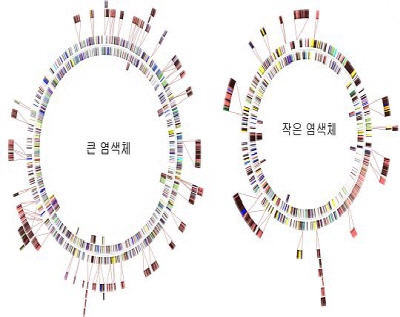
Genomic sequencing of mutated bacteria becomes possible in 2 days
Genomic sequencing of mutated bacteria becomes possible in 2 days Scientists identify mechanism for emergence of mutated cholera bacterium Working through an international study, Korean scientists have identified the mechanism through which pandemic cholera bacterium evolves - a world's first. The Ministry of Education, Science and Technology (Minister Ahn Byung-man) said on August 31 that the research teams led by Prof. Chun Jong-sik at Seoul National University and Dr. Kim Dong-wook at the International Vaccine Institute (IVI) analyzed 23 cholera biotypes, becoming the first in the world to identify the cause for the emergence of a mutated bacterium and how pathogenic bacteria evolve. The study was conducted jointly by researchers in three countries, namely, the U.S. (University of Maryland), Korea and India. The study was published in the online edition of the Proceedings of National Academy of Sciences. (Photo) The two-chromosome cholera bacterium genome, and the location and size of the 70 genetic groups moving in between genes, which were discovered in this study. Variants consist of different combinations of those genetic groups. According to the study, variants are believed to be generated due to bacteriophage, the virus that infects bacteria. The study is the largest on genomic analysis of microorganisms ever publicized in the world. The University of Maryland and the Department of Energy Joint Genome Institute at the Los Alamos National Laboratory in the U.S. conducted gene sequencing of Vibrio cholerae, while the SNU and IVI teams took charge of bioinformatics analysis. Prof. Chun conducted the study with financial support from the "National Research Laboratory Program", which was funded by MEST and the Korea Research Foundation (President Park Chan-mo). 'Bacteriophage'spawned evolution of cholera bacteria. Cholera is a diarrheal disease caused by the Vibrio cholerae bacteria. It is a deadly infectious disease which, if left untreated, can kill a patient in a matter of 18 hours.?? According to the World Health Organization, cholera infected 170,000 people in 53 countries and killed 4,031 people in 2007. If underreported cholera deaths are taken into consideration, the disease kills an estimated 120,000 people a year. (Photo) Electron microscopic picture of Vibrio cholerae, the bacterium that causes cholera, an infectious diarrheal disease fatal to humans. In Korea, there is a growing chance of cholera outbreaks due to global warming and a rise in seawater temperature; thus, cholera is strictly managed as a Grade 1 infectious disease by health authorities. Cholera is also categorized as a Category B bioterrorism pathogen in the United States. The joint team of international researchers conducted genomic sequencing of 23 V. cholerae strains that had been collected from around the world since 1910, and analyzed them using the latest bioinformatics techniques. The researchers found that the transition from the sixth to seventh pandemic involved a transformation of the pathogen into a wholly new strain, and that different strains that emerged or are emerging during the current seventh pandemic are clones that recently evolved from the same ancestor. The researchers concluded that mutated bacteria emerging every several years are spawned by bacteriophage, the virus that infects bacterium. They found that many of the genes that play key roles in triggering diseases, including cholera toxic, a main culprit of diarrhea, are transferred between bacteria due to this virus. 6,000 genes from the 23 V. cholerae stains discovered. Unlike humans, bacteria can transmit and receive genes between themselves. The researchers identified about 70 new genetic groups that move between bacteria. They found that as bacteria are created in the body in various combinations of those genetic groups, new mutated bacteria strains emerge. The identification of the evolutionary mechanism of pathogenic bacteria has paved the way to promptly cope with newly emerging strains of bacteria, and to efficiently develop vaccines and therapeutics. (Photo) Copepod, a type of animal plankton, on which cholera bacterium often resides. According to the study, cholera bacteria concentrate on the surface of this plankton, where they exchange genes between themselves. In the study, the researchers discovered as many as 6,000 genes from the 23 V. cholerae stains. The researchers believe that the entire genetic pool of cholera bacteria that exist in nature contains hundreds of thousands of genes. Accordingly, they predict that a more virulent and infectious mutated bacterium can emerge any time. The study, the largest in scale among studies on microorganism genomes ever publicized, also provides an important clue to the mechanism of how new strains emerge in other pathogenic bacteria, including anthrax, shigella, typhoid, helicobacter pylori, and streptococcus pneumoniae. Moreover, by using the database developed through the study, scientists can now diagnose a mutated cholera strain that emerges anywhere in the world, including Korea, in a matter of 48 hours through genomic analysis. Prof. Chun, who led the study, explained the significance of the findings, saying that "By discovering the evolutionary mechanism of the cholera bacterium - the cause of a disease that was difficult to efficiently control due to its frequent mutations -? the study has laid a scientific foundation and serves as a milestone that is essential to accurate diagnosis and vaccine development." He added, "By taking the lead in the development of a genomic database for major infectious pathogens, Korea has established the groundwork to effectively cope with a national crisis amid a growing possibility for cholera outbreaks in Korea due to global warming." Genome and Lateral gene transfer A genome is a constellation of genes, and is a blueprint of a given organism. The human genome consists of 3 billion bases, while the cholera bacterium genome comprises about 4 million. Humans have about 25,000 genes, while the cholera bacterium contains 4,000.Humans have identical genes, while different cholera strains have genes that can be different by a factor of up to 10 percent. Bacteria have the capacity to lose genes and acquire new ones from other bacterium, a phenomenon called 'Lateral gene transfer'. Cholera bacterium, Vibrio cholerae Cholera is a fatal diarrheal disease that is caused by Vibrio cholerae, a gram negative bacterium. The disease is prevalent in Asia and Africa, primarily near the tropical region. Recently, a major outbreak in southern Africa killed thousands of people. Cholera causes illness only in men, while swine cholera, which afflicts pigs, is a disease that is caused by a virus, which is a totally different microorganism. Cholera is highly infectious in humans, but Vibrio cholerae resides primarily in seawater. Notably, the bacterium are found at the mouth of rivers where freshwater meets the ocean and where the salinity level of seawater declines. It is known to? attach itself to animal plankton, rather than residing in the water itself. According to a study published in the journal 'Nature' in 2000 by Gregory M. Luiz of the Smithsonian Environmental Institute, cholera was found in 93 percent of the ballast water (water contained in vessels to keep the balance of the vesselas buoyancy) in freight ships navigating through the Chesapeake Bay in the United States, As the cholera bacterium can spread via freight ships navigating across different continents, the International Maritime Organization enacted an international treaty on ballast water management, which calls for the level of cholera contamination in the water to be less than one bug per 100 ml of water. (http://www.imo.org/Conventions/mainframe.asp?topic_id=867) ? Kim Chung-han chkim at kofac.or.kr [September 15, 2009] - - - - - - -Source - ScienceTimes -
252009. 09
No. 34 View. 15619
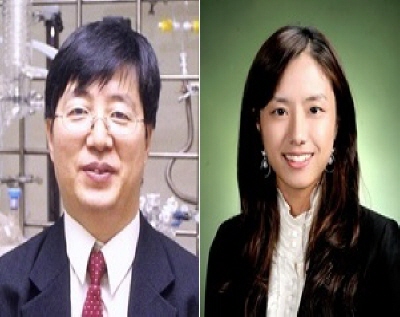
POSTECH scientists develop eco-friendly, terabyte-class data storage technology
POSTECH scientists develop eco-friendly, terabyte-class data storage technology Study published September 14 in online issue of Nature Nanotechnology. (Photo) Prof. Kim Jin-kon, and Jo A-ra, a doctoral program student at POSTECH. Korean scientists have developed a new technology that is capable of storing 1.03 terabyte, a volume equivalent to 1,250 movie titles, per 2.54 square centimeters, roughly the size of a fingernail. A research team led by Professor Kim Jin-kon at Pohang University of Science and Technology (POSTECH) said on September 14 that it developed a technology that allows for the production of a nanopattern that can store ultrahigh density data at terabyte levels on a polystyrene-block-poly (n-pentyl methacrylate), or a copolymer film, based on pressure at room temperature, by using a technology that stores data by a process in which the Atomic Force Microscope probe tip is made to come into mechanical contact with a copolymer surface. Unlike conventional technology that requires the heating of the probe to up to the 350 degree Celsius-level to produce such storage, the new technology allows for the generation of a pattern at room temperature, which drastically reduces energy consumption due to high temperature formation, and thus constitutes an eco-friendly technology, an advantage that is drawing keen attention. U.S. technology giant IBM, which is striving to develop next-generation terabyte-class information storage media, adopts research technology using a device that heats up the ATM tip to up to 350 degrees Celsius to induce plasticity in copolymer film during the string of procedures for data storage. However, IBM's method renders it difficult to produce a tip that can be used at high temperatures, and exhibits heat conductivity of only 0.3% or less through the copolymer film. As a result, this method is low in efficiency and consumes a large volume of energy, which is required for controlling temperatures. In order to overcome such shortfalls, Kim's team developed a polystyrene-block-poly on its own. The material will ultimately allow for the development of ultrahigh-density data storage media at room temperature using its pressure plasticity. Kim said, "We have developed a technology that allows us to easily produce nanopatterns by using a copolymer block that can generate a nano structure at room temperature merely with pressure." adding, "The study has laid the groundwork for the development of technology for ultrahigh-density data storage media, which global enterprises are scrambling to develop." Meanwhile, the study, which was conducted by Prof. Kim and doctoral student Jo A-ra jointly with LG Electronics, was published on September 14 in the online edition of Nature Nanotechnology, a world renowned scientific journal in the nanotechnology field. (Photo) Artist rendition and Atomic Force Microscope image of the production process of the ultrahigh density nanopattern. Artist renditions (a-d) and Atomic Force Microscope image (3-h) of production process of ultrahigh density nanopattern for application as data storage media. Process of writing (b), reading (c), and erasing (d) patterns using the AFM probe tip at room temperature after creating polystyrene-block-poly (n-pentyl methacrylate), or PS-b-PnPMA, on Silicon wafer. ? Lim Eun-heeredant645 at hellodd.com[September 25, 2009]- - - - - - -Source - HelloDD.com -
212009. 09
No. 33 View. 16025

Exchange Program between KISTI and ISTIC
Dr. Zhao Xiaoyuan, a staff from Institute of Scientific and Technical Information China(ISTIC, China), visited KISTI for exchange program from September 7 to 11. During her 5-day visit to KISTI, she had opportunities for understanding the work of Information Center and Information Analysis Center of KISTI. She visited major research divisions of KISTI, had a chance to discuss S&T information related activities with specialists of KISTI and also built her human network with KISTI's staffs. This exchange program is a part of MoU that KISTI and ISTIC concluded in 2005 to promote understanding of major research activities of both organizations and to develop collaborative R&D projects. -
162009. 09
No. 32 View. 14294
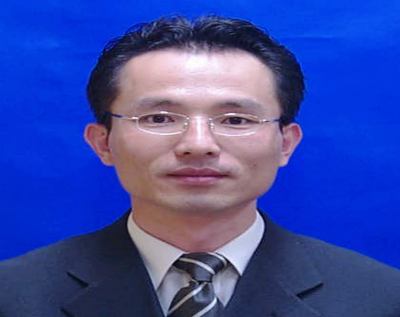
Dr. Kwon, Cho to be listed on Marquis Who's Who
Semior researcher??????? ResearcherDr. Kwon, Oh-Jin????????? Dr. Cho, Kwang-Jong Two KISTI researchers, Dr. Kwon, Oh-Jin, senior researcher with Information Analysis Department and Dr. Cho, Kwang-Jong, researcher with Supercomputing Center, have been listed in the 2010 edition of Marquis Who's Who, a U.S.-based publisher of biographical information. Marquis Who's Who is one of the top-three biographical publishers in the world, along with American Biographical Institute and the international Biographical Centre of Cambridge, England. -
142009. 09
No. 31 View. 14182 KISTI and Samsung Electronics Co. signed a memorandum of understanding to increase cooperation on September 10. According to the agreement, the two organizations will collaborate in research activities concerning establishment of sensing infrastructure for new technology. KISTI will provide the information of National Digital science Links(NDSL), which provides one click service on up-to-dated science and technology information.

-
042009. 09
No. 30 View. 15388
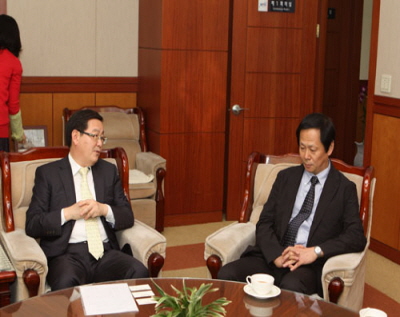
KISTI Holds Seminar on Information Dissemination and Technology Transfer
KISTI held the Seminar on Information Dissemination and Technology Transfer and experts from JST Japan(Japan Science and Technology Agency) were invited to talk at the seminar, which was held in association with KISTI's benchmarking on advanced institutes, between August 31 and September 1 at its head office in Daejeon. The seminar sought to promote executive understanding of each other, as well as benchmark advanced other institutes effectively. And the topics discussed during the seminar were as follows; △A-STEP △J-STAGE △Journal at rchive △Metadata Exchange △J-Global. This seminar was attended by a number of KISTI researchers who were interested in the subject. -
252009. 08
No. 29 View. 15573
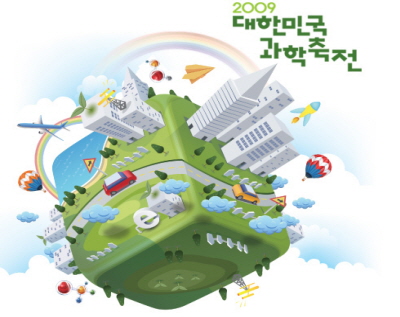
KISTI takes part in Science Festival between Aug. 4 and9
Korea Science Festival 2009, one of the Korean largest science festivals, kicked off its six-day run on August 4 at the Korea International Exhibition Center in Ilsan, Gyeonggi Province. Hosted by the Ministry of Education, Science and Technology, this festival will run until August 9, Sunday from 10 a.m. to 5 p.m. without admission fee. The opening ceremony began 11 a.m. and attendants include Science Minister Ahn Byong-man, Defense Minister Lee Sang-hee, former science ministers, lawmakers and Korean scientists. At this festival, with the slogan "Green World to Be Drawn with Science," KISTI displays its research achievements, provides various science experience programs and also tries to promote membership of KISTI Junior, the KISTI's website for children and students with the aim of popularization of science. The festival has been held for the 13th time, which first began in 1997. ?

 Delete Article!
Delete Article!